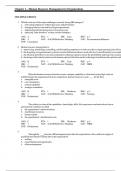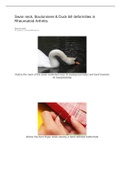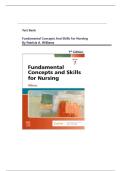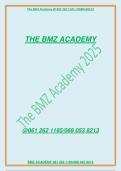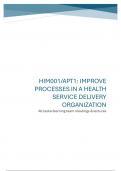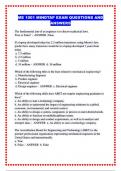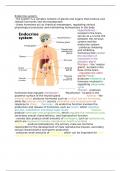TEST BANK FOR CONCEPTUAL FOUNDATIONS 7TH EDITION BY FRIBERG
Conceptual Foundations 7th Edition Friberg
Test Bank
Chapter 01: A Brief History of the Professionalization of Nursing in the United States
Friberg: Conceptual Foundations: The Bridge to Professional Nursing, 7th Edition
MULTIPLE CHOICE
1. Historically, women were considered the obvious choice for nursing sick patients, because:
a. caring for others was an extension of their homemaker role.
b. early nurses were nuns, so the public was used to women in nursing.
c. men, who had education, were reluctant to try nursing.
d. women were often at home anyway, so caregiving was easy.
ANS: A
Women’s domestic role (as homemakers and mothers) was naturally associated with the
caregiving required in nursing. Although religious orders did play a role in health care, it was
the domestic duties of women that set the stage for their involvement in nursing. Widespread
education for men and women is a fairly new phenomenon and did not play a role in the early
history of nursing. Women did not care for sick or injured strangers in their homes, so being at
home was irrelevant.
2. Florence Nightingale’s views about trained nurses were most influenced by her:
a. experiences in wartime.
b. ideas about sanitation.
c. relationships with physicians.
d. view of education.
ANS: A
Nightingale’s experiences in wN arU
tiR
mSeI
deNmGoTnB
st.
raC
teO
dMto her that trained nurses were valuable in
decreasing morbidity and mortality among soldiers. Nightingale had revolutionary ideas about
hospital sanitation, but these are not credited with her advocacy of using trained nurses. Early
trained nurses were taught to follow the directions of the physician; collegial relationships
were not a part of health care practice in Nightingale’s day. Nightingale’s views of education
were influenced by her opinion on the value of trained nurses, not the other way around.
3. A nursing instructor explains to students that the major goal of the Society of Superintendents
of Training Schools for Nurses of the United States and Canada was to:
a. improve working conditions for students.
b. obtain legal recognition for the profession.
c. raise and standardize the training of nurses.
d. reverse discrimination in admissions policies.
ANS: C
The goals of the Society of Superintendents were “to promote fellowship of members, to
establish and maintain a universal standard of training, and to further the best interests of the
nursing profession.” Students were expected to work in apprenticeships during their education
in the hospital-based programs in existence at the time. Obtaining legal recognition for nurses
was the goal of the Nurses’ Associated Alumnae of the United States and Canada, later
renamed the American Nurses Association. Discrimination in nursing existed well into the
civil rights era and beyond, with men and women of color routinely being banned from
admission and employment.
PRIMEXAM.COM
, TEST BANK FOR CONCEPTUAL FOUNDATIONS 7TH EDITION BY FRIBERG
4. Today’s nurse understands that legal recognition for nurses was imperative to:
a. allow nurses to expand beyond the hospital setting.
b. lobby for better wages and working conditions.
c. protect the public from untrained nurses.
d. provide hospitals with accreditation requirements.
ANS: C
The goal of the Nurses’ Associated Alumnae of the United States and Canada (renamed the
American Nurses Association in 1912) was to protect the public from untrained nurses by
securing legal recognition for trained nurses. Graduate nurses predominantly worked as
private duty nurses up through the early 20th century. Wages remained low, and working
conditions remained long and arduous in hospitals (and seasonal for private duty nurses) until
hospitals began hiring more graduate nurses in the 1930s. Hospital accreditation is a recent
phenomenon, unattached to legal recognition for nurses.
5. Which patient would most likely have been cared for in a hospital in the 19th to early 20th
century?
a. Dying patient
b. Contagious patient
c. Homeless patient
d. Woman in labor
ANS: C
Hospitals were considered places for people who had no one else to care for them.
Most patients were cared for in their homes. A dying patient probably would have been cared
for at home. A patient with a communicable illness would have probably been confined to his
or her home. Women in labor typically had their children at home.
6. Lillian Wald’s contribution to nursing can best be described as the:
a. creation of community health nursing.
b. development of college-based nursing schools.
c. establishment of the Navy Nurse Corps.
d. foundation of maternal-child nursing.
ANS: A
Wald responded to the changing social conditions in the late 1800s by establishing the Henry
Street Settlement and Henry Street Visiting Nurse Services in response to the horrendous
health conditions she witnessed in New York City. Wald was not involved in establishing
college-based nursing programs. Wald was not involved in establishing the Navy Nurse
Corps. Wald was not involved in establishing maternal-child nursing as a specialty, although
she did care for many new mothers and their infants as part of her community nursing role.
7. Which event eventually led to the creation of military nursing?
a. American Civil War
b. Spanish-American War
c. World War I
d. World War II
ANS: B
PRIMEXAM.COM
, TEST BANK FOR CONCEPTUAL FOUNDATIONS 7TH EDITION BY FRIBERG
During the Spanish-American War, trained nurses cared for soldiers suffering from yellow
fever. This convinced the military and Congress of the need for qualified nurses and set the
stage for the eventual creation of the Army Nurse Corps in 1901 and the Navy Nurse Corps in
1908. During the Civil War, both sides wanted women to care for injured and ill soldiers, but
these women were mostly untrained volunteers from the middle and upper classes. World War
I occurred after the creation of the Army Nurse Corps and the Navy Nurse Corps. World War
II occurred after the creation of the Army Nurse Corps and the Navy Nurse Corps.
8. A faculty nurse explaining the stratification in nursing roles seen today tells students that the
most important event leading to this development was:
a. desegregation in nursing.
b. limited nursing opportunities.
c. the Korean conflict.
d. World War II.
ANS: D
The United States’ involvement in World War II dramatically increased the demand for
trained nurses. To help fill this need, the American Red Cross and the Office of Civilian
Defense co-established a program to train nurse aides. The success of the program encouraged
hospitals to use employees with various levels of skill. Desegregation in nursing did come
about in the same era as stratification, but it was not instrumental in creating this
differentiated practice. Nursing opportunities were increasing throughout the 20th century.
Role stratification was already entrenched by the Korean conflict.
9. Discrimination against African-American nurses began to wane during:
a. Kennedy’s presidency.
b. the civil rights era.
c. the Vietnam War.
d. World War II.
ANS: D
World War II saw discrimination against African Americans begin to wane with the end of
segregation in the military Nurse Corps. At the end of World War II, many state nurses
associations ended their discrimination in membership as well; by 1952, all state nurses
associations had eliminated such discriminatory policies. Kennedy’s presidency, although
known for civil rights advancements, was not when discrimination began to end. The civil
rights era occurred at approximately the same time as the Kennedy era. The Vietnam War
occurred at the same time as Kennedy’s presidency and civil rights era.
10. Between the years 1950 and 1967, the number of nurses and assistive personnel rose
dramatically in part as a result of the influence of the:
a. Children’s Bureau.
b. Hill-Burton Act.
c. Nurse Training Act.
d. Social Security Act.
ANS: C
PRIMEXAM.COM
, TEST BANK FOR CONCEPTUAL FOUNDATIONS 7TH EDITION BY FRIBERG
The Nurse Training Act provided funding for nursing student education through scholarships,
loans, recruitment, school construction and maintenance, and special educational projects.
Until its passage, federal funding for nursing education was modest at best. The Children’s
Bureau was created in 1912 in response to concerns about women and children’s health. The
Hill-Burton Act provided federal funds for hospital construction and health care centers. The
Social Security Act of 1935 included financial aid for older adults and Title V health care
benefits for children with disabilities.
11. Mildred Montag’s major contribution to nursing is considered to be:
a. encouraging minority women and men to enter nursing.
b. establishing associate degree nursing programs.
c. fighting for improved wages and recognition for nurses.
d. paving the way for the military to use trained nurses.
ANS: B
In response to the severe nursing shortage in the post–World War II years, Montag proposed a
2-year nursing associate degree that would prepare technical nurses in community colleges.
Montag was not known for encouraging minorities and men to enter nursing. Montag’s major
accomplishment was not fighting for improved wages and recognition. Montag was not
involved in the military’s use of trained nurses.
12. Which nursing organizations are responsible for providing continuing education, establishing
practice standards, and offering certification examinations for their members?
a. Councils of nurse educators
b. National specialty organizations
c. State boards of nursing
d. State nurses associations
ANS: B
National specialty organizations, such as the American Association of Critical Care Nurses,
arose in response to the developing nursing specialties; these organizations offer continuing
education, practice standards, and certification exams for their members. Organizations that
consist of nurse educators would be primarily concerned with nursing education. State boards
of nursing are charged with the legal oversight of nursing in their respective states. State
nurses associations are often lobbying and marketing organizations for nursing within a
specific state and act as the state arms of the American Nurses Association.
13. What influence did Loretta Ford and Henry Silver have on the nursing profession?
a. Advocated for laws allowing autonomous practice
b. Created a major scholarship for nursing education
c. Designed the first doctoral nursing program
d. Opened the first nurse practitioner program
ANS: D
Loretta Ford and Henry Silver opened the first nurse practitioner program (in pediatrics) at the
University of Colorado in 1965. They did not advocate for laws allowing autonomous
practice, create a major scholarship, or design the first nursing doctoral program.
14. What change is anticipated that will guide advanced practice nursing roles?
a. Changes in federal funding for advanced education
b. Declining demand for advanced practice roles
PRIMEXAM.COM
Conceptual Foundations 7th Edition Friberg
Test Bank
Chapter 01: A Brief History of the Professionalization of Nursing in the United States
Friberg: Conceptual Foundations: The Bridge to Professional Nursing, 7th Edition
MULTIPLE CHOICE
1. Historically, women were considered the obvious choice for nursing sick patients, because:
a. caring for others was an extension of their homemaker role.
b. early nurses were nuns, so the public was used to women in nursing.
c. men, who had education, were reluctant to try nursing.
d. women were often at home anyway, so caregiving was easy.
ANS: A
Women’s domestic role (as homemakers and mothers) was naturally associated with the
caregiving required in nursing. Although religious orders did play a role in health care, it was
the domestic duties of women that set the stage for their involvement in nursing. Widespread
education for men and women is a fairly new phenomenon and did not play a role in the early
history of nursing. Women did not care for sick or injured strangers in their homes, so being at
home was irrelevant.
2. Florence Nightingale’s views about trained nurses were most influenced by her:
a. experiences in wartime.
b. ideas about sanitation.
c. relationships with physicians.
d. view of education.
ANS: A
Nightingale’s experiences in wN arU
tiR
mSeI
deNmGoTnB
st.
raC
teO
dMto her that trained nurses were valuable in
decreasing morbidity and mortality among soldiers. Nightingale had revolutionary ideas about
hospital sanitation, but these are not credited with her advocacy of using trained nurses. Early
trained nurses were taught to follow the directions of the physician; collegial relationships
were not a part of health care practice in Nightingale’s day. Nightingale’s views of education
were influenced by her opinion on the value of trained nurses, not the other way around.
3. A nursing instructor explains to students that the major goal of the Society of Superintendents
of Training Schools for Nurses of the United States and Canada was to:
a. improve working conditions for students.
b. obtain legal recognition for the profession.
c. raise and standardize the training of nurses.
d. reverse discrimination in admissions policies.
ANS: C
The goals of the Society of Superintendents were “to promote fellowship of members, to
establish and maintain a universal standard of training, and to further the best interests of the
nursing profession.” Students were expected to work in apprenticeships during their education
in the hospital-based programs in existence at the time. Obtaining legal recognition for nurses
was the goal of the Nurses’ Associated Alumnae of the United States and Canada, later
renamed the American Nurses Association. Discrimination in nursing existed well into the
civil rights era and beyond, with men and women of color routinely being banned from
admission and employment.
PRIMEXAM.COM
, TEST BANK FOR CONCEPTUAL FOUNDATIONS 7TH EDITION BY FRIBERG
4. Today’s nurse understands that legal recognition for nurses was imperative to:
a. allow nurses to expand beyond the hospital setting.
b. lobby for better wages and working conditions.
c. protect the public from untrained nurses.
d. provide hospitals with accreditation requirements.
ANS: C
The goal of the Nurses’ Associated Alumnae of the United States and Canada (renamed the
American Nurses Association in 1912) was to protect the public from untrained nurses by
securing legal recognition for trained nurses. Graduate nurses predominantly worked as
private duty nurses up through the early 20th century. Wages remained low, and working
conditions remained long and arduous in hospitals (and seasonal for private duty nurses) until
hospitals began hiring more graduate nurses in the 1930s. Hospital accreditation is a recent
phenomenon, unattached to legal recognition for nurses.
5. Which patient would most likely have been cared for in a hospital in the 19th to early 20th
century?
a. Dying patient
b. Contagious patient
c. Homeless patient
d. Woman in labor
ANS: C
Hospitals were considered places for people who had no one else to care for them.
Most patients were cared for in their homes. A dying patient probably would have been cared
for at home. A patient with a communicable illness would have probably been confined to his
or her home. Women in labor typically had their children at home.
6. Lillian Wald’s contribution to nursing can best be described as the:
a. creation of community health nursing.
b. development of college-based nursing schools.
c. establishment of the Navy Nurse Corps.
d. foundation of maternal-child nursing.
ANS: A
Wald responded to the changing social conditions in the late 1800s by establishing the Henry
Street Settlement and Henry Street Visiting Nurse Services in response to the horrendous
health conditions she witnessed in New York City. Wald was not involved in establishing
college-based nursing programs. Wald was not involved in establishing the Navy Nurse
Corps. Wald was not involved in establishing maternal-child nursing as a specialty, although
she did care for many new mothers and their infants as part of her community nursing role.
7. Which event eventually led to the creation of military nursing?
a. American Civil War
b. Spanish-American War
c. World War I
d. World War II
ANS: B
PRIMEXAM.COM
, TEST BANK FOR CONCEPTUAL FOUNDATIONS 7TH EDITION BY FRIBERG
During the Spanish-American War, trained nurses cared for soldiers suffering from yellow
fever. This convinced the military and Congress of the need for qualified nurses and set the
stage for the eventual creation of the Army Nurse Corps in 1901 and the Navy Nurse Corps in
1908. During the Civil War, both sides wanted women to care for injured and ill soldiers, but
these women were mostly untrained volunteers from the middle and upper classes. World War
I occurred after the creation of the Army Nurse Corps and the Navy Nurse Corps. World War
II occurred after the creation of the Army Nurse Corps and the Navy Nurse Corps.
8. A faculty nurse explaining the stratification in nursing roles seen today tells students that the
most important event leading to this development was:
a. desegregation in nursing.
b. limited nursing opportunities.
c. the Korean conflict.
d. World War II.
ANS: D
The United States’ involvement in World War II dramatically increased the demand for
trained nurses. To help fill this need, the American Red Cross and the Office of Civilian
Defense co-established a program to train nurse aides. The success of the program encouraged
hospitals to use employees with various levels of skill. Desegregation in nursing did come
about in the same era as stratification, but it was not instrumental in creating this
differentiated practice. Nursing opportunities were increasing throughout the 20th century.
Role stratification was already entrenched by the Korean conflict.
9. Discrimination against African-American nurses began to wane during:
a. Kennedy’s presidency.
b. the civil rights era.
c. the Vietnam War.
d. World War II.
ANS: D
World War II saw discrimination against African Americans begin to wane with the end of
segregation in the military Nurse Corps. At the end of World War II, many state nurses
associations ended their discrimination in membership as well; by 1952, all state nurses
associations had eliminated such discriminatory policies. Kennedy’s presidency, although
known for civil rights advancements, was not when discrimination began to end. The civil
rights era occurred at approximately the same time as the Kennedy era. The Vietnam War
occurred at the same time as Kennedy’s presidency and civil rights era.
10. Between the years 1950 and 1967, the number of nurses and assistive personnel rose
dramatically in part as a result of the influence of the:
a. Children’s Bureau.
b. Hill-Burton Act.
c. Nurse Training Act.
d. Social Security Act.
ANS: C
PRIMEXAM.COM
, TEST BANK FOR CONCEPTUAL FOUNDATIONS 7TH EDITION BY FRIBERG
The Nurse Training Act provided funding for nursing student education through scholarships,
loans, recruitment, school construction and maintenance, and special educational projects.
Until its passage, federal funding for nursing education was modest at best. The Children’s
Bureau was created in 1912 in response to concerns about women and children’s health. The
Hill-Burton Act provided federal funds for hospital construction and health care centers. The
Social Security Act of 1935 included financial aid for older adults and Title V health care
benefits for children with disabilities.
11. Mildred Montag’s major contribution to nursing is considered to be:
a. encouraging minority women and men to enter nursing.
b. establishing associate degree nursing programs.
c. fighting for improved wages and recognition for nurses.
d. paving the way for the military to use trained nurses.
ANS: B
In response to the severe nursing shortage in the post–World War II years, Montag proposed a
2-year nursing associate degree that would prepare technical nurses in community colleges.
Montag was not known for encouraging minorities and men to enter nursing. Montag’s major
accomplishment was not fighting for improved wages and recognition. Montag was not
involved in the military’s use of trained nurses.
12. Which nursing organizations are responsible for providing continuing education, establishing
practice standards, and offering certification examinations for their members?
a. Councils of nurse educators
b. National specialty organizations
c. State boards of nursing
d. State nurses associations
ANS: B
National specialty organizations, such as the American Association of Critical Care Nurses,
arose in response to the developing nursing specialties; these organizations offer continuing
education, practice standards, and certification exams for their members. Organizations that
consist of nurse educators would be primarily concerned with nursing education. State boards
of nursing are charged with the legal oversight of nursing in their respective states. State
nurses associations are often lobbying and marketing organizations for nursing within a
specific state and act as the state arms of the American Nurses Association.
13. What influence did Loretta Ford and Henry Silver have on the nursing profession?
a. Advocated for laws allowing autonomous practice
b. Created a major scholarship for nursing education
c. Designed the first doctoral nursing program
d. Opened the first nurse practitioner program
ANS: D
Loretta Ford and Henry Silver opened the first nurse practitioner program (in pediatrics) at the
University of Colorado in 1965. They did not advocate for laws allowing autonomous
practice, create a major scholarship, or design the first nursing doctoral program.
14. What change is anticipated that will guide advanced practice nursing roles?
a. Changes in federal funding for advanced education
b. Declining demand for advanced practice roles
PRIMEXAM.COM

